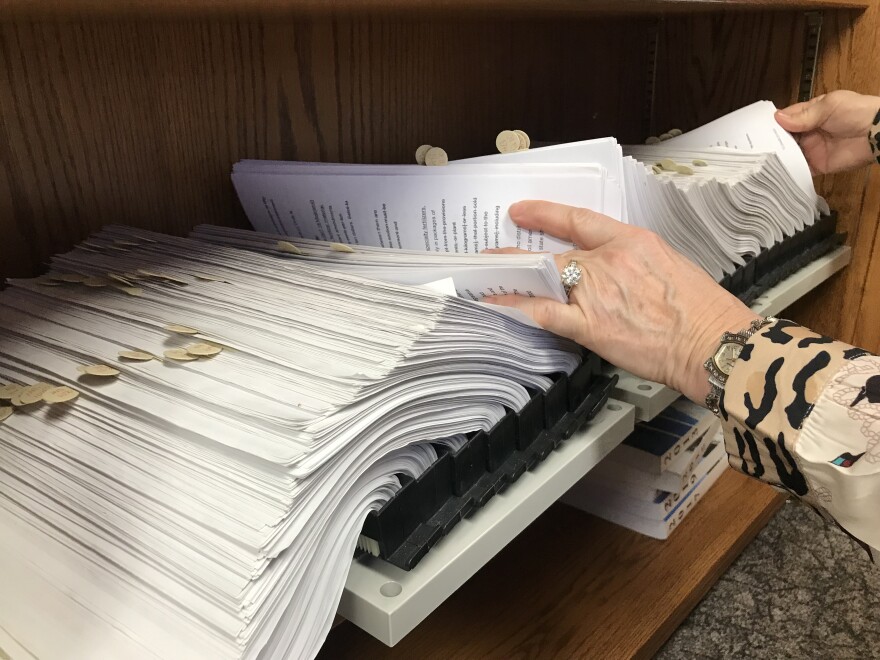For decades, North Dakota lawmakers used massive bill books at their desks to read and track legislation. Bill books were heavy and cumbersome and required constant updates for amendments. The process was tedious and involved a blizzard of paper and a lot of time.
Pages were assigned a certain number of bill books to update. They used glue-sticks to paste amendments onto the pages in a flip-up style so lawmakers could see the previous writing. Every five bills were tabbed. Amendments were color-coded for where they came from, the House or Senate. The pages’ worst fear was a lawmaker standing up during a floor session to say “I don’t have that amendment,” which would prompt a scramble before a vote.
In the 1965 session, the House of Representatives had four floor clerks whose sole job was to update the bill books of the majority and minority leaders and assistant leaders. The Senate had several attendants to handle all the bill books for the 49 senators.
In 1981, the House bills were nearly a foot high; the Senate bills were about 7 or 8 inches. The average bill was two pages long, and could cover one to 60 or more sections of state law.
In 1983, the Legislature processed more than 1,400 bills and resolutions and 1,100 amendments. All that paper took the form of bill books two and a half feet thick!
Disassembly of lawmakers’ bill books was a sign of a session’s end, such as on this date in 1991. Clerks took down the bill books, which some lawmakers liked to take home. The flurry of paper was stunning. In one week during the ‘91 session, Senate pages pasted 135 amendments into each of the 45 bill books!
Computers were gradually introduced to the Legislature, beginning in 1989. In 1998, every lawmaker had the option of using a portable computer. The transition to computers meant the Legislature didn’t need as many employees to handle paper. From 1993 to 1999, the Legislature went from 136 employees to 92.
Some lawmakers shunned computers, including two senators who still used bill books as late as 2007. The 2009 session was the first in which every lawmaker used a laptop.
Dakota Datebook by Jack Dura
Sources:
- The Bismarck Tribune. 1965, February 9. Page 3: Legislative pages are much like tiny gears in workings of watch
- The Bismarck Tribune. 1981, April 2. Page 17: In retrospect: Freshman senator shares impressions of the session
- The Bismarck Tribune. 1983, April 22. Page 20: Some left with legislative chores
- The Bismarck Tribune. 1991, March 3. Page 2C: Legislators work long hours, employees say
- The Bismarck Tribune. 1991, April 7. Page D1: Tear-down of books signal end of session
- The Bismarck Tribune. 1998, December 13. Page 2: Legislature ready to go online
- The Bismarck Tribune. 2001, February 19. Page 12A: Email: Irate comments don’t sway lawmaker
- The Bismarck Tribune. 2007, February 2. Page 2B: The big, BIG book
- The Bismarck Tribune. 2007, April 1. Page 3C: Holdouts of the information age
- The Bismarck Tribune. 2009, January 6. Page B1: Point-and-click legislature
- The Bismarck Tribune. 2009, April 25. Page 1B: Legislators push a lot of paper
- North Dakota Legislative Council. (2021, December 20). LEGISLATIVE SESSIONS - DATES OF CONVENING AND ADJOURNING SINCE STATEHOOD. Retrieved from: ndlegis.gov/files/resource/library/lsdcass.pdf
- Dura, J. (2021, December 13). Legislature’s computers. Prairie Public, Dakota Datebook. Retrieved from: news.prairiepublic.org/podcast/dakota-datebook/2021-12-13/legislatures-computers
- Interview with Renae Doan. 2023, March 2




